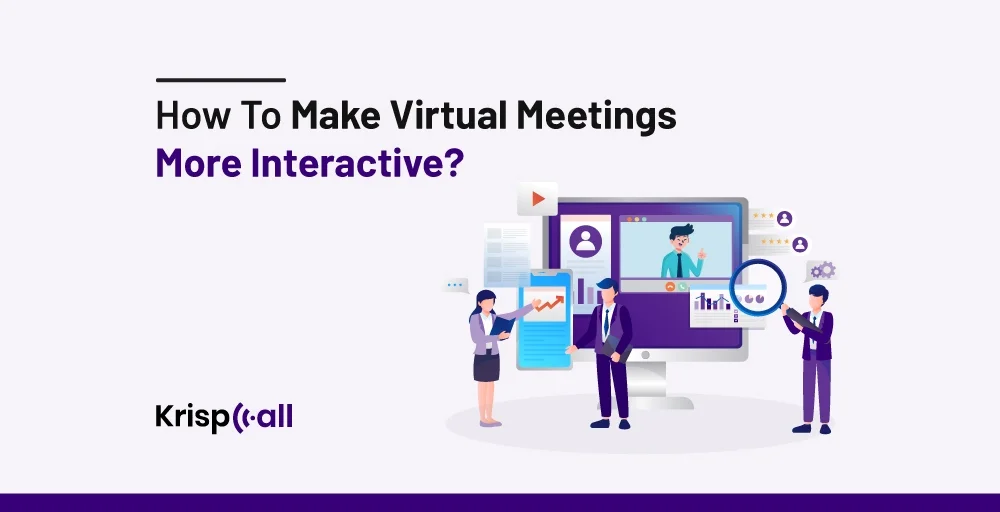Coming to the 21st century, the way we work has undergone a radical transformation. Remote work is booming, making virtual meetings the cornerstone of modern business communication.
However, enduring a dull virtual meeting can feel like a chore. Without employees physically present, maintaining their focus can be challenging, leading to distractions and yawning.
Therefore, it’s essential to inject fun and interaction into virtual meetings to foster stronger connections among team members despite the physical distance.
To help you with this, we’ve composed this article, in which we will discuss how to make virtual meetings more interactive to keep participants involved and motivated. You will also learn about some of the tools that you can use for remote meetings.
🔑 KEY HIGHLIGHTS
- Virtual meetings should always be kept interactive to be impactful and result-oriented.
- Virtual meetings can be made interactive and fun by having an agenda, keeping them short, using visuals and multimedia, circulating roles, gamifying the meeting experience, etc.
- Some common challenges when keeping participants engaged in virtual meetings include technical issues, distractions at home, lack of engagement, and ineffective facilitation.
- Some tools used for remote meetings are Slack, Zoom, Microsoft Teams, Go To, etc.
Common challenges in keeping participants engaged during virtual meetings
There are several challenges associated with keeping participants engaged during virtual meetings. Some of these are:
1. Technical issues
Participants attending virtual meetings often experience poor internet connections. This can result in a lag in audio and video, difficulties accessing shared documents, or even difficulty joining the meeting platform. These issues can disrupt the flow of the meeting and cause frustration among the participants.
2. Distractions at home
Working from home is thought to be flexible and easy, but it comes with its own set of distractions. These distractions may occur due to family members, pets, or household chores. It can also further divert participants’ attention away from the meeting and make it challenging to stay concentrated during the discussion.
3. Lack of engagement
Virtual meetings can sometimes feel monotonous and one-sided when there is less interaction. When there are fewer interactions, the opportunities for collaboration and generating new ideas become less. Without active participation from all participants, meetings can become dull and impersonal, which will lead to decreased involvement.
4. Lack of Non-verbal Cues
During a face-to-face meeting, nonverbal cues such as facial expressions and body language help to understand each other better. But, during virtual meetings, these cues are often lacking, making it challenging to identify the moods or reactions of others. In the absence of these cues, participants may feel disconnected during the meetings and lack engagement.
5. Ineffective facilitation
Poorly managed discussions lead to unclear agendas or objectives being set. These unclear objectives can further leave the participants feeling lost or uninterested. When there is no clear direction from the facilitator, participants may struggle to engage in the discussion. They may even fail to see the value in their participation.
How do we make virtual meetings more interactive?
Virtual meetings can be ineffective if one doesn’t know the appropriate methods to make such meetings interactive. Here are some tips you can adopt to make virtual meetings more interactive:
1. Make and share the agenda beforehand
To make meetings more efficient, it is recommended to prepare and share a clear and defined agenda before starting the meeting. The agenda may include things like how the meeting will go, who will attend the meeting, and the topics to be discussed further.
This structured agenda makes sure that everyone knows what to expect and what is expected of them during the meeting. Also, it helps to keep the meeting more focused and prevents the discussions from going off the track.
For example, if it is a project update meeting, the agenda may include sections on project progress, upcoming milestones, and any blockers. Or, if you are conducting a brainstorming session, the agenda may include the list of major discussion points and goals for generating ideas.
2. Keep meetings short

Usually, an individual’s concentration span lasts up to 45 minutes, and engagement sharply drops after 30 minutes. Therefore, short meetings are more effective in terms of involvement and engagement. Besides, they also reflect respect for participants’ time, making them feel valued and dedicated.
Also, with a limited time window, participants are more likely to stay focused, concentrate, and contribute to the meeting meaningfully.
For example, you can set a clear, fixed time limit for the meeting and strictly try to stick to it. If your meeting is aimed at a regular status update, aim for 30 minutes or less. However, if your meeting is aimed at in-depth discussions or decision-making, you can extend it to 60 minutes, but no longer.
3. Use icebreakers and warm-ups
Using icebreakers has always been an effective way to ignite the meeting. This will help the participants feel safe speaking up with ideas, concerns, and questions. Also, a quick icebreaker at the beginning can get everyone talking and help build team culture in the long run.
You can also ask questions or perform certain activities related to the meeting topic or even out of the topic to create a friendly atmosphere.
For example, you can ask meeting participants to share one interesting thing they did over the weekend. Or, if the meeting is about team goals, you can even ask participants to share one professional goal they have for the upcoming quarter.
4. Use visuals and multimedia

Always include visuals, videos, or multimedia elements to make presentations more engaging. You can add multimedia elements such as videos, images, or presentations and use them to illustrate key points and provide examples. The meeting organizer can also share screens to display worksheets, videos, slideshows, etc, and can also drop external links in the chat.
For example, you can use a short video or animation to introduce a topic or highlight key points. Or, if you are discussing customer feedback, show a brief video clip of customer testimonials to provide context and engage participants emotionally.
5. Gamify the meeting experience
Gamifying the meeting means adding gamification elements to make it more fun and engaging. Some examples of gamification are trivia quizzes, challenges, or interactive games related to the meeting content. This technique seems to be effective at work since it has shown a positive impact on productivity.
For example, at the end of every agenda topic, you can conduct a poll for the team to rank its effectiveness from 1-10. Then, after ranking each topic, keep the list of top scorers. You can also ask the participants to write, draw, or even act out their ideas to see their creative ideas.
6. Limit the number of participants
The fewer the participants, the better. When there are fewer participants, each individual has more opportunities to contribute and take part in discussions. Fewer participants also reduce the likelihood of feeling overwhelmed or lost in a large group. A smaller number of participants also improve focus and participation.
Moreover, limiting the number of participants decreases the chances of the meeting being dragged on longer. The smaller groups will lead to meaningful conversations and faster decision-making.
For example, suppose you are conducting a project planning meeting, and instead of inviting the entire team, you can just invite the key stakeholders. The stakeholders may be the project manager, team leads, and heads of relevant departments.
7. Encourage them to use a webcam
Using a webcam in virtual meetings creates a sense of human connection. The visual cues from facial expressions and body language make it easier to understand both parties, enhancing better communication.
It further helps to develop a more interactive and engaging environment since the participants feel they’re meeting physically. Moreover, using webcams makes the participants accountable since they are more likely to stay focused, knowing they are watched all the time.
For example, if you are the speaker in the meeting, you can set the tone by simply turning on your own webcam from the beginning of the meeting. This will encourage others to do the same. You can say something like, “Let’s all turn on our webcams so we can see each other beautiful faces and have a more personal connection.”
8. Circulate roles
When the specific roles are assigned to the participants at each meeting, they happen to be actively involved and accountable for the meeting’s success. This will encourage a sense of ownership and collaboration among participants as each one of them will contribute to the meeting’s outcome.
The rotating roles will also support the participants in developing diverse skill sets, such as facilitation, time management, and note-taking, within the team.
For example, suppose you are conducting a virtual meeting, you can assign different roles to participants, such as facilitator, timekeeper, note-taker, etc. You can also regularly rotate these roles so that everyone gets a chance to take on different responsibilities.
9. Live demos or simulations
When you present live demos or simulations it makes the meeting more dynamic and engaging. It also provides a hands-on experience for participants by making complex concepts more accessible.
In the live demo and simulations, users can provide immediate feedback or resolve queries, leading to productive discussions and problem-solving. Also, when you practically see the tool in action, it will help the participants to learn even faster and retain information longer.
For example, suppose you are discussing a newly launched software feature or a product, you may conduct a live demonstration. This way, the participants can see the feature in action and ask questions immediately improving efficiency. You can also use simulation tools to help you walk through the process.
10. Feedback and reflection

Feedback is a significant factor when it comes to virtual meetings. It helps to identify the level of effectiveness of the meeting and areas for improvement. By providing the opportunity for the participants to reflect on key takeaways and insights, it facilitates learning.
The feedback may sometimes take the form of polls and surveys before discussing a specific point, which will result in better interaction. Also, the action items generated from the feedback ensure that discussions lead to the progress of the meeting.
For example, you can allocate a few minutes at the end of the meeting for feedback and reflection. There, you can ask the participants questions such as one thing they found valuable from the meeting, one thing that could be improved, or one action item they’re taking away.
Tools for remote meetings
Since virtual meetings are becoming more popular every day, the number of remote meeting tools is also increasing. It is often difficult to choose the right tool for your virtual meetings. But before choosing any tool, you need to be clear about who will use it and how they will use it.
Some of the popular tools used for remote meetings are:
- Slack: Slack is popular for integrating various communication channels into one app. It helps to streamline the work by flagging messages, sharing files, sending notes, making voice and video calls, reducing internal emails, etc.
- Zoom: Zoom is one of the best video conferencing tools available today. It offers a reliable and user-friendly platform for remote meetings. Its features include screen-sharing, breakout rooms, and recording capabilities.
- Microsoft Teams: Microsoft Teams is another tool used for video conferencing. This tool combines chat, video conferencing, and file sharing in one place. It integrates well with other Microsoft 365 applications, making it ideal for organizations already invested in that ecosystem.
- Google Meet: Google Meet offers a simple and intuitive interface for video conferencing, making it easy for teams to connect remotely. With features like screen sharing and real-time collaboration, it’s a valuable asset for remote teams.
Final Thoughts
Today, virtual meetings have become quite popular, but managers are worried about it being tedious and less impactful. Making these meetings interactive is key.
In order to make these virtual meetings interactive, you need to start by sharing clear agendas, keeping meetings short, using visuals, multimedia, etc. Business managers can also use the tools, like Slack, Zoom, Microsoft Teams, etc, for effective communication and collaboration.
FAQ
How do you make virtual meetings fun?
You can make virtual meetings fun in the following ways;
- You can include engaging visuals like slides, videos, or GIFs.
- Incorporate interactive games such as quizzes, polls, or team challenges.
- Organize host-themed meetings with costumes or decorations.
- Always end meetings with optional social time or games.
- You can also invite guest speakers or surprise guests for a change of pace.
How do you keep the audience engaged in virtual meetings?
You can keep the audience engaged in virtual meetings by making the meetings more interactive through polls, chats, and Q&A sessions.





